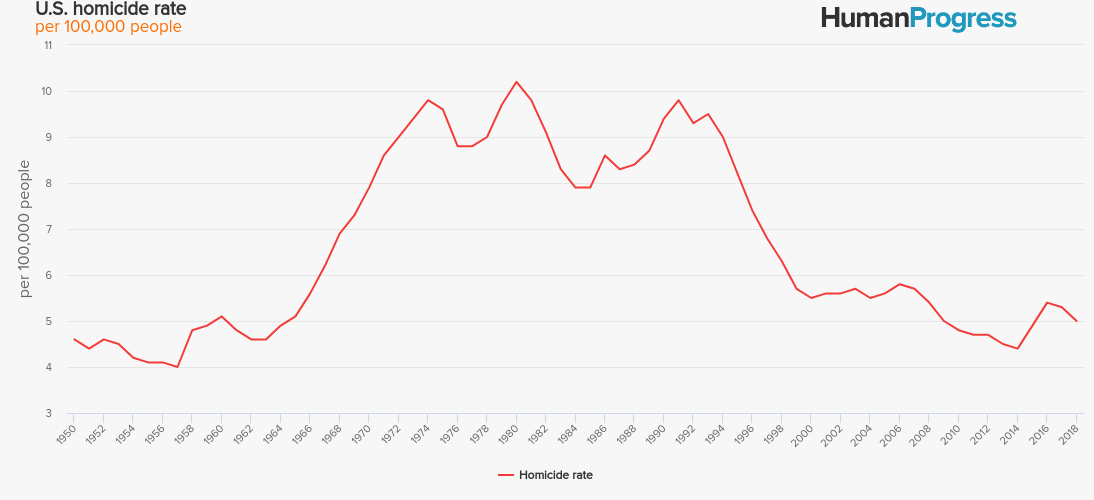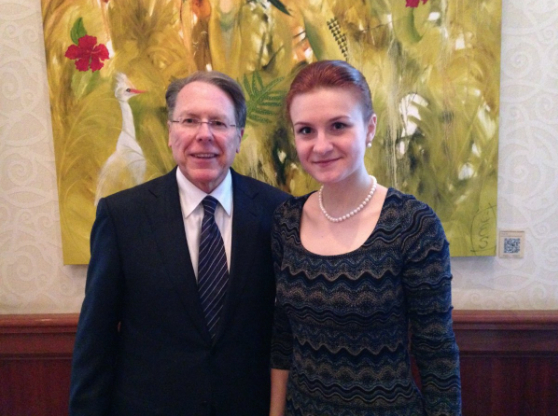2aguy
Diamond Member
- Jul 19, 2014
- 111,975
- 52,247
- 2,290
Here we have a piece that looks at Violence in America and guns. It finds that guns do not drive our violence rates and it does so in great detail....

 medium.com
medium.com
-----In short, a dramatic liberalization of gun policy and attitudes toward guns, accompanied by a surge in gun ownership (especially of the types of weapons politicians today are most ready to demonize), has been correlated with an equally dramatic decrease in violence.
----
3. The U.S. is not especially violent in a broad global context.
Let’s return to international comparisons.
Again, it’s true that the United States has much less restrictive gun laws, and a much higher homicide rate, than, say, the U.K. or Japan. But that’s only half of the story: The U.S. also has much less restrictive gun laws than all of the countries that are more violent.
Our neighbors, Canada and Mexico, serve to illustrate this phenomenon perfectly. Both countries have much more restrictive gun laws than those of the U.S. In 2017, Canada had a homicide rate of almost 2 per 100,00 — a bit higher than most European countries, but significantly lower than the U.S. homicide rate of 5 per 100,000. However, Mexico’s 2017 homicide rate was much higher at a whopping 25 per 100,000.
What’s responsible for Canada’s relative peace and Mexico’s relative violence? That’s a complicated question far beyond the scope of this piece. What we can say for certain, though, is that “guns” and “gun laws” are not the fundamental answer. If it were that simple, the United States — with by far the most guns and the most permissive gun laws of the three — would be the most violent, with Canada (a country with more permissive gun laws and twice as many guns per capita as Mexico) close behind, and Mexico as the most peaceful of three.
In reality, not only is Mexico more violent than the U.S. and Canada, it’s more violent by an enormous degree. Once again, we see that “guns” and “gun control” (or the lack thereof) fail to explain differences in observed levels of violence.
---Do the areas of the U.S. with the highest rates of violence also have the most permissive gun laws? No. The magazine Guns and Ammo ranked each state by the gun-friendliness of its laws — the farther down the list (that is, the higher the value of its rank number) that a state is, the more restrictive its gun policies are. In the chart below, each state has been plotted according to its 2018 gun-friendliness rank and its 2018 homicide rate. (The far outlier is Washington, DC.)
-----
Some gun control proponents have argued that differences in state/local gun control are mostly meaningless because it’s easy for people to simply import guns from other jurisdictions: guns remain readily available pretty much everywhere, despite state or municipal gun controls. Therefore, national-level gun control is needed to meaningfully curb violence.
It’s true that, for those willing to break laws, guns are readily available everywhere in the United States, despite varying degrees of gun control in different jurisdictions. But if it were true that national-level gun control would result in uniformly low levels of gun violence, then we should expect to see a uniformly high level of violence within the existing (relatively) permissive framework. Instead, we observe Louisiana, with a homicide rate five times higher than that observed in Utah — my very gun-friendly home state. The argument that national-level gun control would resolve the apparent disconnect between gun control and violence fails.
The extreme unevenness of violence within the United States casts further doubt upon the narrative that said violence is a gun policy problem.
The Reality of American Violence
There is a powerful and pervasive narrative about violence in America that goes something like this:
 medium.com
medium.com
-----In short, a dramatic liberalization of gun policy and attitudes toward guns, accompanied by a surge in gun ownership (especially of the types of weapons politicians today are most ready to demonize), has been correlated with an equally dramatic decrease in violence.
----
3. The U.S. is not especially violent in a broad global context.
Let’s return to international comparisons.
Again, it’s true that the United States has much less restrictive gun laws, and a much higher homicide rate, than, say, the U.K. or Japan. But that’s only half of the story: The U.S. also has much less restrictive gun laws than all of the countries that are more violent.
Our neighbors, Canada and Mexico, serve to illustrate this phenomenon perfectly. Both countries have much more restrictive gun laws than those of the U.S. In 2017, Canada had a homicide rate of almost 2 per 100,00 — a bit higher than most European countries, but significantly lower than the U.S. homicide rate of 5 per 100,000. However, Mexico’s 2017 homicide rate was much higher at a whopping 25 per 100,000.
What’s responsible for Canada’s relative peace and Mexico’s relative violence? That’s a complicated question far beyond the scope of this piece. What we can say for certain, though, is that “guns” and “gun laws” are not the fundamental answer. If it were that simple, the United States — with by far the most guns and the most permissive gun laws of the three — would be the most violent, with Canada (a country with more permissive gun laws and twice as many guns per capita as Mexico) close behind, and Mexico as the most peaceful of three.
In reality, not only is Mexico more violent than the U.S. and Canada, it’s more violent by an enormous degree. Once again, we see that “guns” and “gun control” (or the lack thereof) fail to explain differences in observed levels of violence.
---Do the areas of the U.S. with the highest rates of violence also have the most permissive gun laws? No. The magazine Guns and Ammo ranked each state by the gun-friendliness of its laws — the farther down the list (that is, the higher the value of its rank number) that a state is, the more restrictive its gun policies are. In the chart below, each state has been plotted according to its 2018 gun-friendliness rank and its 2018 homicide rate. (The far outlier is Washington, DC.)
-----
Some gun control proponents have argued that differences in state/local gun control are mostly meaningless because it’s easy for people to simply import guns from other jurisdictions: guns remain readily available pretty much everywhere, despite state or municipal gun controls. Therefore, national-level gun control is needed to meaningfully curb violence.
It’s true that, for those willing to break laws, guns are readily available everywhere in the United States, despite varying degrees of gun control in different jurisdictions. But if it were true that national-level gun control would result in uniformly low levels of gun violence, then we should expect to see a uniformly high level of violence within the existing (relatively) permissive framework. Instead, we observe Louisiana, with a homicide rate five times higher than that observed in Utah — my very gun-friendly home state. The argument that national-level gun control would resolve the apparent disconnect between gun control and violence fails.
The extreme unevenness of violence within the United States casts further doubt upon the narrative that said violence is a gun policy problem.

